- Joined
- Mar 28, 2001
- Messages
- 6,341
Now that I''ve polished my rhino''s horn.

Sir John,
I''ve just read through this thread again carefully and studied all the images you have provided.
I understand explicitly what you''re saying but I don''t think you realize exactly what we''re observing through LightScope here and *why* I am under the conviction (at this point in time) that what I am observing through the crown is the direct results of facet yaw. Everything you have written in response does not refute anything I''ve written or the results I''ve shared.
> It''s not due to out of roundness as the diamond in the example is a tightly cut stone (.04mm deviation, not enough to alter optical design to the degree that you''ve implying).
> It''s also not due to tilting. A cursory examination of the LightScope image as compared to the Gem Advisor model confirms this. The model is based on the Sarin Scan which is laid down on its table ensuring perfect leveling. If the diamond were tilted you would see the obvious difference in the patterning between the LS image and the GA model.
First let me clarify my understanding of and agreement with some of the comments you''ve made.
For clarification we are discussing the tilt of the pavilion mains NOT on the vertical or slope (north/south deviations) but on the horizontal (across the mains). The graphic below clarifies.
You had stated that facet yaw on the pavilion mains can not be observed on the pavilion mains in the face up view due to obscuration.
I would agree with this.
The twisting of the pavilion main in the horizontal direction (even in the slightest bit) can not be observed by examining the mains face up. They will appear black in reflector technology and assessing yaw on the mains in that view IS impossible. HOWEVER when you twist a pavilion main facet the direct results is what I believe I am observing in the lower girdles and in the face up position through LightScope.
I have not see anything that disproves this even in everything you have written. Next post I''ll illustrate.
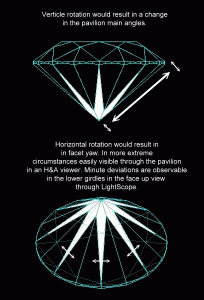

Sir John,
I''ve just read through this thread again carefully and studied all the images you have provided.
I understand explicitly what you''re saying but I don''t think you realize exactly what we''re observing through LightScope here and *why* I am under the conviction (at this point in time) that what I am observing through the crown is the direct results of facet yaw. Everything you have written in response does not refute anything I''ve written or the results I''ve shared.
> It''s not due to out of roundness as the diamond in the example is a tightly cut stone (.04mm deviation, not enough to alter optical design to the degree that you''ve implying).
> It''s also not due to tilting. A cursory examination of the LightScope image as compared to the Gem Advisor model confirms this. The model is based on the Sarin Scan which is laid down on its table ensuring perfect leveling. If the diamond were tilted you would see the obvious difference in the patterning between the LS image and the GA model.
First let me clarify my understanding of and agreement with some of the comments you''ve made.
For clarification we are discussing the tilt of the pavilion mains NOT on the vertical or slope (north/south deviations) but on the horizontal (across the mains). The graphic below clarifies.
You had stated that facet yaw on the pavilion mains can not be observed on the pavilion mains in the face up view due to obscuration.
I would agree with this.
The twisting of the pavilion main in the horizontal direction (even in the slightest bit) can not be observed by examining the mains face up. They will appear black in reflector technology and assessing yaw on the mains in that view IS impossible. HOWEVER when you twist a pavilion main facet the direct results is what I believe I am observing in the lower girdles and in the face up position through LightScope.
I have not see anything that disproves this even in everything you have written. Next post I''ll illustrate.


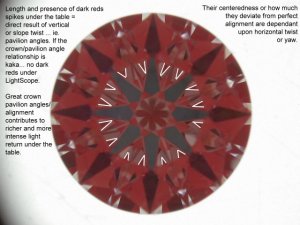


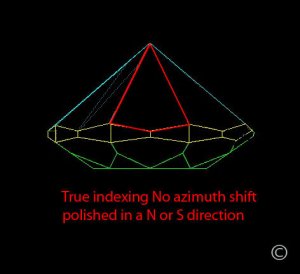
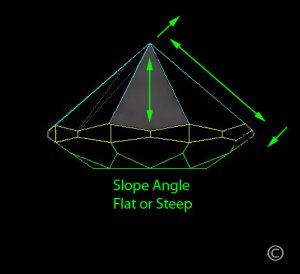
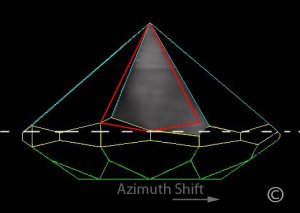
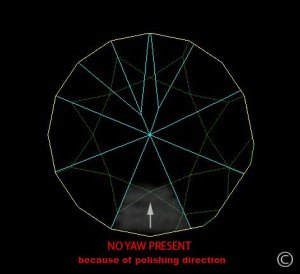
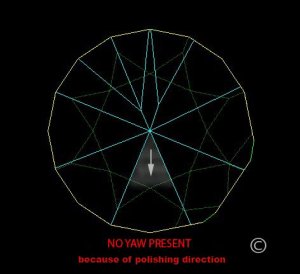
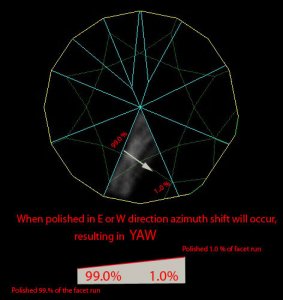
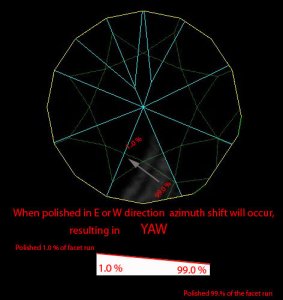

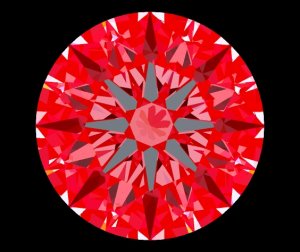
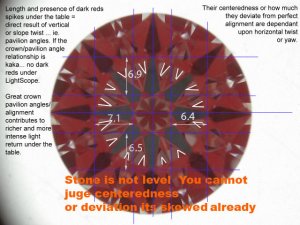








300x240.png)